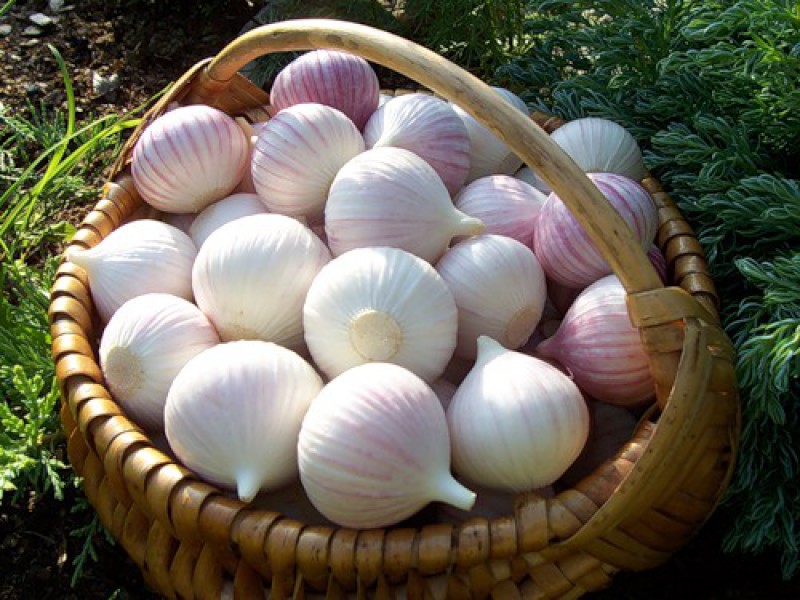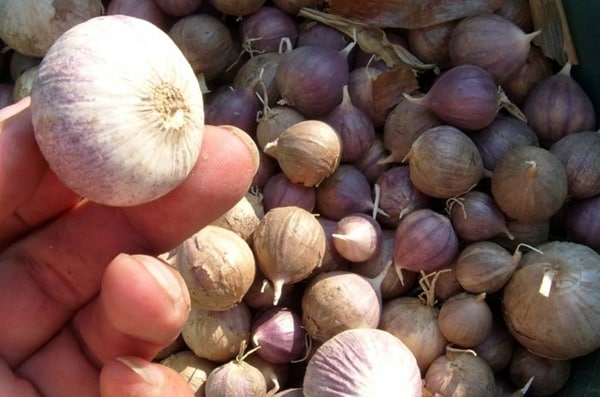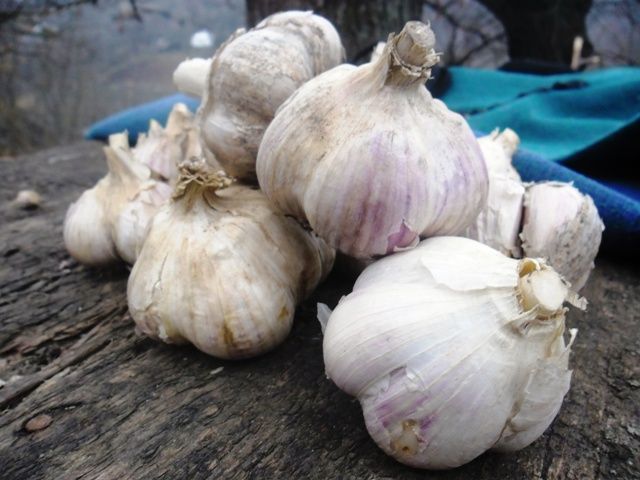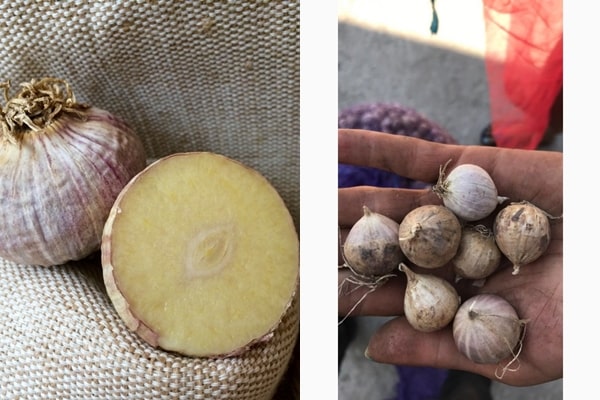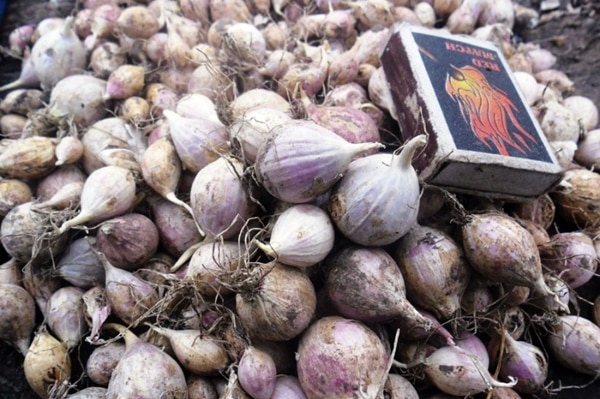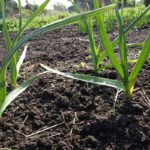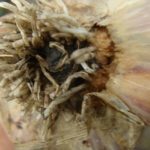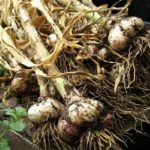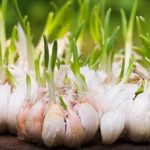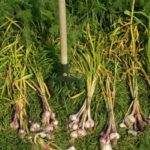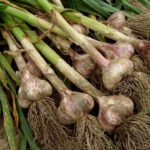Single clove garlic is a crop that is obtained by planting the best airy bulbs. For several years in a row, gardeners have been using a similar method of propagating garlic. Why him? This helps not only to get a rich harvest, but also to renew it. This procedure is necessary to keep the vegetable yield at a high level.
What is a one-toothed one?
The seed material, which is intended for obtaining one-tooth, is winter-hardy.It is practically not affected by diseases and various pests, in particular nematodes. It brings a rich harvest, compared to the amount that is obtained as a result of planting ordinary cloves.
The aerial bulbs used to produce one-toothed bulbs are the size of barley or oats. They are small. The shape of some varieties may vary. There are almost round or slightly oval cloves. In rare cases, they look like a pea.
How to grow garlic from air plants?
Planting garlic using aerial bulbs is carried out 2 times a year:
- spring varieties are planted in early spring after the last frost;
- winter - a month before the onset of frost.
Winter garlic is planted at the end of September or until mid-October. Air bulbs are placed in the ground in the standard way - lowercase. There should be at least 20 cm between the rows. To avoid mistakes, it is recommended to adhere to the following scheme - 45–50 cloves per linear meter.
How to care for crops?
Care of crops must be regular. If a gardener has planted winter bulbs, the soil should be covered with a large amount of snow. There may not be enough precipitation during the winter. In this case, all the snow is raked into the beds. This approach will ensure early seedlings.
Dry weather negatively affects the growth of seedlings. If a person lives in a region with an arid climate, he must take care of thoroughly watering the crop. The beds must be watered at least once a month. Particular attention should be paid to watering in May.
Crops also need feeding. The fertilizer application procedure occurs in two stages. At the end of March and until the beginning of April, the soil is saturated with nitrophoska. In the first week of June, the beds are sprinkled with wood ash and ammophos.
Single-tooth landing
Single clove garlic is an ideal planting material. A large and strong culture grows from it, which has many cloves. The plant segments take root without problems and tolerate winter well. When to plant planting material?
They adhere to the winter planting scheme - late September-early October.
Before planting garlic, planting material needs to be sorted. Size plays an important role in this matter. Depending on the size, garlic is divided into classes:
- first - from 12 to 15 mm;
- the second - from 10 to 12 mm.
If the seeding is much smaller, it is no longer suitable for planting in the soil. The winter variety should be planted in 2–4 rows at once, maintaining a distance of 40–45 cm. Garlic seeds are deepened no more than 7 cm. After creating a hole, you need to pour 1 tbsp into it. spoon of sand and place the sevok on top. Then fill the pea with a small amount of the same sand.
Thanks to this approach, the garlic beds will be protected from soil wetting and crop rotting. This is a kind of micro-drainage. As soon as the planting of garlic is completed, a little compost is added to the holes and sprinkled with earth. If arrows appear on the seedlings, they must be removed. And do this as soon as they reach at least 5 cm in length.
The arrows are removed under the third sheet. If this is not done, the crop yield will decrease significantly.
Top dressing
Single clove garlic, like other crops, needs feeding. Fertilizers are applied in several stages - the end of April, the first days of May and the beginning of June. Special preparations nourish the plant, supplying it with the missing microelements. In spring and summer in dry climates, it is recommended to water the beds once a week.
When to collect one-toed?
Throughout the entire stage of crop development, it is necessary to monitor how garlic grows. Particular attention is paid to the end of the growing season before harvesting. Constant observation helps determine when to remove garlic. Typically, the harvest time coincides with the beginning of yellowing of the tips of the leaves. In addition, the feathers begin to lie down.
If a person cannot decide when to plant garlic in the soil, there should be no doubt when digging it up. Harvesting garlic is very quick. If you wait a while with this matter, the feathers will dry out and die. At the same time, the bulb begins to go deeper into the soil, this affects the digging of the crop and leads to its reduction.
Tools for work
With one-toothed plants grown on large plots of land, proceed as follows - the roots are trimmed using ordinary staples. After this, the crop is selected from the soil by hand. The dug up garlic needs to be dried. To do this, it is transferred to a special room and left for several days.
When seedlings are grown in the garden and small plots of land, the amount of work is reduced. It is recommended to dig up garlic from the ground using a shovel. As soon as it is completely knocked out of the ground, it is adjusted to the side. The culture is left in this position until it dries completely.
Post-harvest work
Harvested garlic can be dried in several ways. Some varieties are left in the beds and, if necessary, covered with film. Usually an attic or shed is suitable for this venture. From collected and well-dried cloves, the feather is torn off, which goes into the stem. Then they clear the ground and cut off the roots, sorting them by size and putting them aside for further storage in a dry and ventilated room.
More about classes
Taking into account the size of the garlic, it is determined which class the vegetable belongs to - I or II. If the parameters of the clove correspond to the first class, in further development the head will turn out to be normal. A smaller set forms an unusual onion, and one large one without cloves. It is used as planting material.
This approach makes it possible to obtain material for propagating valuable varieties. It can be stored for 2–3 years, without deteriorating the quality of the crop, but only increasing it. When planting winter and spring garlic adhere to the main recommendations. This allows you to obtain a large onion for further propagation and consumption.
One clove is garlic, which is a material for planting, which has technological advantages compared to a regular clove:
- Features a round appearance. In this case, the size may change, but the shape does not. Regular teeth are elongated.
- The center of mass of single-clove garlic coincides with the center of the pea itself. The center of mass of the clove is shifted to the bottom.
- The single-tooth shape is similar to a pea, so it allows for calibration before planting.
- Planted seeds have a healthy immune system, so they are not susceptible to parasites and vegetable diseases.
- It takes root without problems and survives the winter.
- Garlic, which grew from a single clove, produces a harvest the very next year.
- A large onion does not need to be peeled.
- The yield of single cloves is much higher than cloves of the same mass when planted.
Despite the many advantages, culture also has disadvantages. Fortunately, there is only one - a higher price, which is explained by the labor costs in growing, caring for and cleaning.
Important nuances
To get the maximum crop yield, take into account the interesting features of the planting material. If you dig up a one-toothed tree, it falls into a natural state of rest. This can be adjusted using the temperature setting. If the crop begins to deteriorate, a person looks for the reasons for this, without even thinking about the temperature. To ensure normal storage, the room must be between 5 and 10 °C.
Failure to maintain the temperature will bring the crop out of dormancy.
Growing single clove garlic is not the only important condition for obtaining a harvest. Enough attention is paid to the storage location. The room should be well ventilated, dry and cool. For storage, nets or boxes are used, which are placed on racks.
If the garlic was grown according to all the rules, premature digging contributes to rapid drying. Among the total storage volume, 2% of single teeth with mechanical damage are allowed.

